View in other NatureServe Network Field Guides
NatureServe
Montana
Utah
Wyoming
Idaho
Wisconsin
British Columbia
South Carolina
Yukon
California
New York
Greenleaf Manzanita - Arctostaphylos patula
Other Names:
Arctostaphylos ×media
State Rank Reason (see State Rank above)
Known from two or three seperate locations in Montana. Population sizes are very small and are susceptible to the negative effects associated with such. Additional negative impacts from timber harvesting, invasive weeds and development are possible.
Primarily a species of the Great Basin and California, and disjunct in Montana. Not known from either Idaho or Wyoming.
General Description
Green-leaf Manzanita is a shrub with reddish brown, spreading stems which are up to 1 m (3 ft) high and can propagate by layering. The alternate, yellow-green leaves have broadly elliptic blades which are 2-5 cm long with entire margins and petioles less than 1/2 as long. Foliage is sparsely covered with short hairs and yellow glands. Short-stalked, pink flowers are clustered in branched inflorescences on the stem tips. The urn-shaped corolla, which is ca. 6 mm long, has 5 short lobes, and the calyx has 5 nearly separate sepals. There are 10 stamens. The brownish, glabrous berry is 7-10 mm across.
Phenology
Flowering in late May-early June, fruiting in August.
Diagnostic Characteristics
This is the only Arctostaphylos species with a bush-stature in our area; distinguished from other bush-forming genera in the Health Family by the fruit which is free of, and not enclosed by, the calyx, alternate leaves, 5-part flowers, and corolla length less than 1 cm. A. uva-ursi has trailing stems that rarely are over 0.2 m tall. Hybrids between these two species are known elsewhere in their range.
Species Range
Montana Range
Range Descriptions
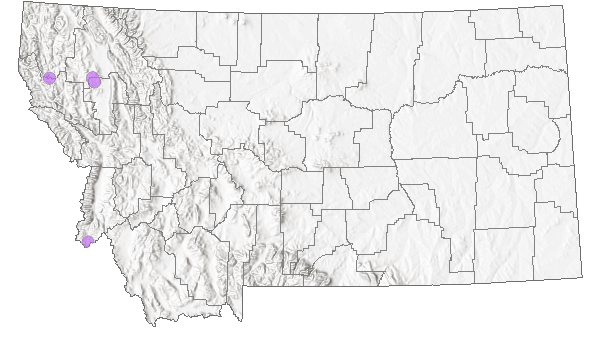
 Native
Native
Range Comments
South-central WA to CA, east to AZ, NV and northwest MT. Disjunct.
Observations in Montana Natural Heritage Program Database
Number of Observations: 8
(Click on the following maps and charts to see full sized version)
Map Help and Descriptions
Relative Density
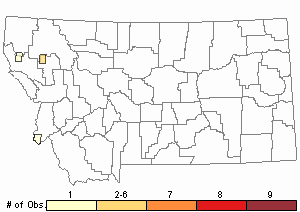
Recency
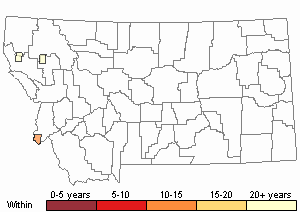

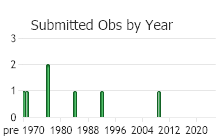
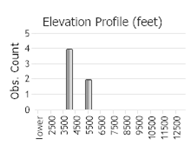 (Observations spanning multiple months or years are excluded from time charts)
(Observations spanning multiple months or years are excluded from time charts)
Habitat
Rocky soil in open coniferous forests in the montane zone.
National Vegetation Classification System Groups Associated with this Species
Forest and Woodland
Low Elevation - Xeric Forest and Woodland
Montane - Subalpine Forest and Woodland
Ecology
POLLINATORS The following animal species have been reported as pollinators of this plant species or its genus where their geographic ranges overlap:
Bombus bifarius,
Bombus melanopygus,
Bombus insularis, and
Bombus flavidus (Thorp et al. 1983, Williams et al. 2014).
Stewardship Responsibility
Threats or Limiting Factors
STATE THREAT SCORE REASON
Reported threats to Montana’s populations of Greenleaf Manzanita are currently assigned as unknown (MTNHP Threat Assessment 2021). Negative impacts due to industrial logging in the vicinity of populations has been indicated, but the time estimated for impacts to materialize exceeds the maximum 10-year timeframe needed to evaluate a threat by the NatureServe method. Information is needed if impacts due to logging expected within 10 years, or from other threats are known.
References
- Literature Cited AboveLegend:
 View Online Publication
View Online Publication MTNHP Threat Assessment. 2021. State Threat Score Assignment and Assessment of Reported Threats from 2006 to 2021 for State-listed Vascular Plants. Botany Program, Montana Natural Heritage Program, Helena, Montana.
MTNHP Threat Assessment. 2021. State Threat Score Assignment and Assessment of Reported Threats from 2006 to 2021 for State-listed Vascular Plants. Botany Program, Montana Natural Heritage Program, Helena, Montana. Thorp, R.W., D.S. Horning, and L.L. Dunning. 1983. Bumble bees and cuckoo bumble bees of California (Hymenoptera: Apidae). Bulletin of the California Insect Survey 23:1-79.
Thorp, R.W., D.S. Horning, and L.L. Dunning. 1983. Bumble bees and cuckoo bumble bees of California (Hymenoptera: Apidae). Bulletin of the California Insect Survey 23:1-79. Williams, P., R. Thorp, L. Richardson, and S. Colla. 2014. Bumble Bees of North America. Princeton, NJ: Princeton University Press. 208 p.
Williams, P., R. Thorp, L. Richardson, and S. Colla. 2014. Bumble Bees of North America. Princeton, NJ: Princeton University Press. 208 p.
- Additional ReferencesLegend:
 View Online Publication
View Online Publication
Do you know of a citation we're missing? Ball C.T., J. Keeley, H. Mooney, J. Seemann, and W. Winner. 1983. Relationship between form, function, and distribution of two Arctostaphylos species (Ericaceae) and their putative hybrids. Acta Oecologica 4:153-164.
Ball C.T., J. Keeley, H. Mooney, J. Seemann, and W. Winner. 1983. Relationship between form, function, and distribution of two Arctostaphylos species (Ericaceae) and their putative hybrids. Acta Oecologica 4:153-164. Diggs, G.M., D. Soltis, and P. Soltis. 1988. Hybridization and genetic variation in Arctostaphylos (Ericaceae). American Journal of Botany 75(6):169.
Diggs, G.M., D. Soltis, and P. Soltis. 1988. Hybridization and genetic variation in Arctostaphylos (Ericaceae). American Journal of Botany 75(6):169. Ellstrand, N.C., J.M. Lee, J.E. Keeley, and S.C Keeley. 1987. Ecological isolation and introgression: biochemical confirmation of introgression in an Arctostaphylos (Ericaceae) population. Acta Oecologica 8:299-308.
Ellstrand, N.C., J.M. Lee, J.E. Keeley, and S.C Keeley. 1987. Ecological isolation and introgression: biochemical confirmation of introgression in an Arctostaphylos (Ericaceae) population. Acta Oecologica 8:299-308. Lesica, P. and P. V. Wells. 1986. Noteworthy collection: Montana. Madrono 33:227-228.
Lesica, P. and P. V. Wells. 1986. Noteworthy collection: Montana. Madrono 33:227-228. Lesica, P., M.T. Lavin, and P.F. Stickney. 2012. Manual of Montana Vascular Plants. Fort Worth, TX: BRIT Press. viii + 771 p.
Lesica, P., M.T. Lavin, and P.F. Stickney. 2012. Manual of Montana Vascular Plants. Fort Worth, TX: BRIT Press. viii + 771 p. Lesica, P., M.T. Lavin, and P.F. Stickney. 2022. Manual of Montana Vascular Plants, Second Edition. Fort Worth, TX: BRIT Press. viii + 779 p.
Lesica, P., M.T. Lavin, and P.F. Stickney. 2022. Manual of Montana Vascular Plants, Second Edition. Fort Worth, TX: BRIT Press. viii + 779 p. Schierenbeck, K.A. 1988. Evolutionary relationships among Arctostaphylos Mewukka and associated species. American Journal of Botany 75(6):204.
Schierenbeck, K.A. 1988. Evolutionary relationships among Arctostaphylos Mewukka and associated species. American Journal of Botany 75(6):204.
- Web Search Engines for Articles on "Greenleaf Manzanita"





